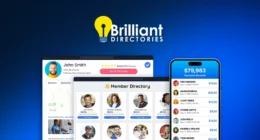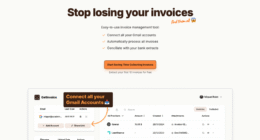Canadian small businesses have several reliable payroll software options that handle complex tax requirements and provincial regulations. Popular choices include PaymentEvolution, WagePoint, and Knit People, which offer automated tax calculations, direct deposit capabilities, and CRA-compliant reporting. Monthly costs typically range from $20-$70 base fee plus $2-$6 per employee. These systems streamline payroll processes by managing CPP, EI, and income tax deductions automatically. Understanding key features and pricing structures helps businesses select the most suitable solution for their needs.
Quick Overview
- PaymentEvolution, WagePoint, and Knit People provide comprehensive payroll solutions specifically designed for Canadian small businesses with automatic tax calculations.
- Monthly costs range from $20-$70 base fee plus $2-$6 per employee, making these solutions affordable for small businesses.
- Essential features include CPP, EI, and income tax calculations, direct deposit capabilities, and automated CRA-compliant reporting.
- Software must handle province-specific regulations and provide regular updates to maintain compliance with changing Canadian tax laws.
- Employee self-service portals allow staff to access pay stubs and tax forms while reducing administrative workload for business owners.
Understanding Canadian Payroll Software Requirements

Running a business in Canada requires meticulous attention to payroll management, especially given the intricate web of provincial and federal regulations. Canadian payroll software must address several critical requirements to guarantee compliance and efficiency.
Managing Canadian payroll demands precision and expertise to navigate complex regulatory requirements at both provincial and federal levels.
Key requirements include precise handling of province-specific regulations, such as Ontario and British Columbia’s Employee Health Tax, alongside proper management of CPP, EI, and income tax calculations. The software needs to accommodate bilingual support, particularly for Quebec-based operations where French documentation is mandatory. Trusted providers like Wagepoint deliver especially intuitive interfaces that make navigating these complex requirements easier.
Essential features should include direct deposit capabilities, automated tax calculations, and thorough reporting tools. For proper compliance, the system must generate and process mandatory documents like T4s, ROEs, and Relevés while maintaining detailed employee records for audit purposes.
Regular updates guarantee adherence to changing minimum wage requirements and tax regulations.
Top Payroll Software Solutions for Canadian Small Businesses
Canadian small businesses can now choose from an impressive array of payroll software solutions that simplify compliance and streamline operations. Leading platforms like PaymentEvolution, WagePoint, and Knit People offer extensive features including automatic tax calculations, direct deposits, and CRA-compliant reporting.
For budget-conscious businesses, free options such as Wave Payroll and TimeTrex provide essential functionality without cost. These solutions handle basic payroll needs while maintaining compliance with Canadian tax regulations. Regular maintenance ensures tax laws and updates are automatically integrated into the software.
Most platforms feature user-friendly interfaces with visual dashboards and guided setup processes, making them accessible even for those new to payroll management. As businesses grow, scalable solutions like Ceridian Dayforce and ADP Small Business Payroll can accommodate increased complexity, offering seamless integration with existing accounting software and HR tools.
Cost Analysis and ROI of Payroll Software Systems

When selecting payroll software, businesses must carefully weigh initial costs against long-term returns to make an informed investment decision. Initial pricing typically includes monthly base fees plus per-employee charges, while long-term benefits encompass time savings and error reduction. Cloud-based solutions provide automatic updates and scalability for growing businesses.
| Cost Component | Monthly Range | ROI Factor |
|---|---|---|
| Base Fee | $20-$70 | Time savings up to 80% |
| Per Employee | $2-$6 | Error reduction |
| Custom Features | $10-$50 | Tax compliance |
| Setup Costs | $100-$500 | Productivity gains |
The investment in payroll software often delivers significant returns through automated processes and reduced labor costs. Small businesses can expect cost efficiency improvements of up to 60% annually compared to manual processing, while also benefiting from enhanced accuracy and compliance with CRA regulations.
Essential Features to Look for in Payroll Software
Selecting the right payroll software requires careful attention to essential features that streamline operations and guarantee compliance. Modern payroll systems should include automated tax management that tracks federal, provincial, and municipal rates while ensuring accurate deductions and timely remittances.
Key features to prioritize include secure direct deposit capabilities, employee self-service portals, and robust reporting tools. The software should offer customizable reports for payroll summaries and tax filings, while providing employees with easy access to their pay stubs and tax forms. Automated compliance monitoring helps businesses stay updated on changing regulations and legal requirements. Integration capabilities with existing HR and accounting systems are vital for seamless operations.
Look for solutions that offer scalability to accommodate business growth, multi-jurisdictional support for companies operating across provinces, and strong security measures to protect sensitive payroll data.
Implementing and Optimizing Your Payroll Software

Successful payroll software implementation demands a strategic approach that combines thorough planning with methodical execution. The process begins with a thorough assessment of business requirements, including workforce size, payroll complexity, and compliance needs specific to Canadian regulations.
To optimize the implementation, organizations should start by registering with the Canada Revenue Agency (CRA) and obtaining a payroll account number. Next, they need to input essential employee data, configure payment schedules, and set up proper deduction categories for CPP, EI, and taxes. Integration with existing HR and accounting systems streamlines workflows while automated features reduce manual tasks. ADP’s platform provides expert bilingual support to ensure smooth implementation across all Canadian provinces, including Quebec.
Regular system updates, ongoing staff training, and periodic audits guarantee the software continues to meet business needs while maintaining compliance with Canadian payroll regulations.
Frequently Asked Questions
Can I Switch Payroll Software Providers Mid-Year Without Affecting Tax Submissions?
Yes, switching payroll software mid-year is possible while maintaining accurate tax submissions. The key is ensuring proper transfer of year-to-date (YTD) data between providers. Most changes work best at quarter-end periods for easier alignment.
Success requires careful planning, including:
- Collecting complete YTD records
- Verifying tax submission accuracy
- Coordinating with both providers
- Double-checking data transfer completeness
With proper preparation, businesses can switch providers without disrupting tax compliance.
How Do Payroll Software Solutions Handle Employees Working Across Multiple Provinces?
While managing employees across provinces may seem challenging, modern payroll software handles this complexity effectively. The systems automatically track work locations, calculate province-specific tax rates, and manage varying benefit deductions.
They guarantee proper allocation of earnings based on time worked in each jurisdiction, generate separate T4 slips per province, and maintain compliance with distinct provincial regulations. Real-time tracking features help employers stay current with multi-jurisdictional requirements.
What Happens to Payroll Data if the Software Company Goes Out of Business?
The impact on payroll data if a software company closes depends on the hosting model. Cloud-based systems may limit data access if proper backups aren’t maintained, while on-premises solutions typically allow continued access to local data.
To protect against this risk, businesses should:
- Maintain regular independent backups
- Export data periodically to secure storage
- Review data ownership terms in service agreements
- Have a contingency plan with alternative providers ready
Are There Specific Payroll Software Solutions for Handling Unionized Employees?
Several powerful payroll software solutions are specifically designed to handle the complex world of unionized employees. These specialized tools tackle everything from intricate collective bargaining agreements to multi-tiered pay rates.
Popular options include HCM TradeSeal, Rise People, and Ceridian Dayforce, which automate union dues calculations, pension contributions, and benefit tracking. These systems guarantee compliance with union rules while substantially reducing administrative workload and potential costly errors.
Can Payroll Software Manage Both Contractors and Employees Simultaneously?
Modern payroll software solutions can effectively manage both contractors and employees within a single platform. These systems offer specialized features for each worker type, including contractor invoice processing, expense tracking, and document storage alongside employee-specific tools like tax deductions and benefits management.
The software streamlines administrative tasks by centralizing worker data while maintaining compliance with distinct payment requirements and tax regulations for both groups.
Conclusion
Research shows that Canadian small businesses using automated payroll software save an average of 5 hours per week compared to manual processing. As payroll technology continues to evolve, choosing the right software solution has become essential for business efficiency and compliance. By carefully evaluating features, costs, and implementation requirements, small business owners can select a payroll system that streamlines operations while meeting Canada’s specific tax and regulatory demands.








